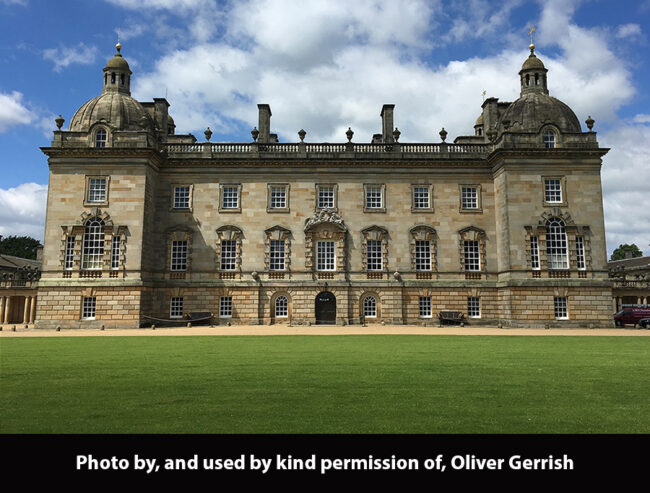
The east facade
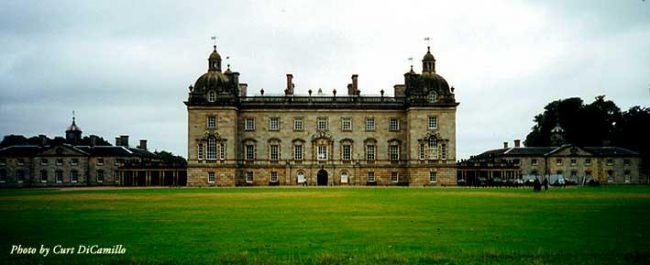
The east facade
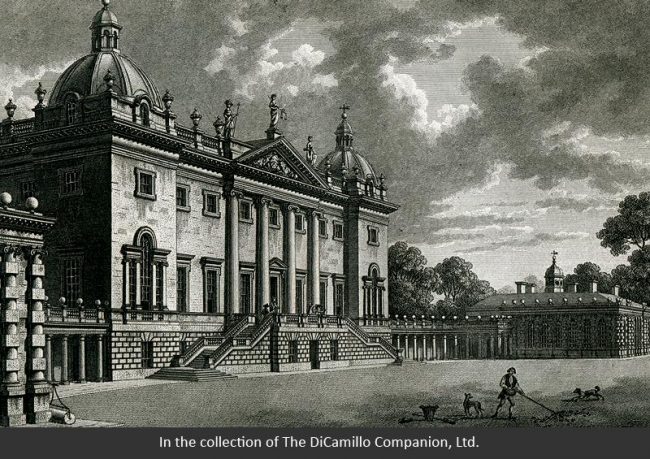
The west facade from the 1782 publication "Watts' Seats of the Nobility and Gentry"
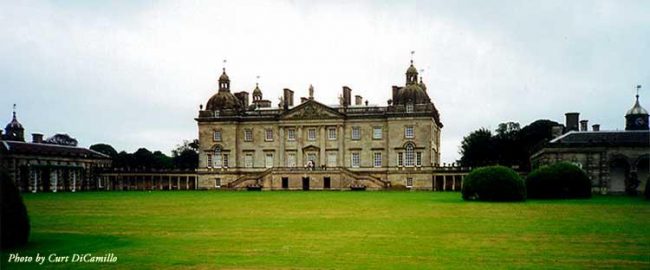
The west facade
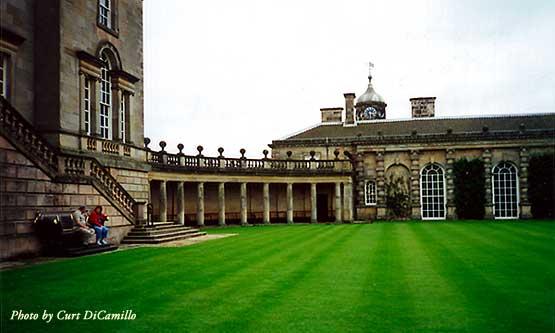
The The west facade forecourt
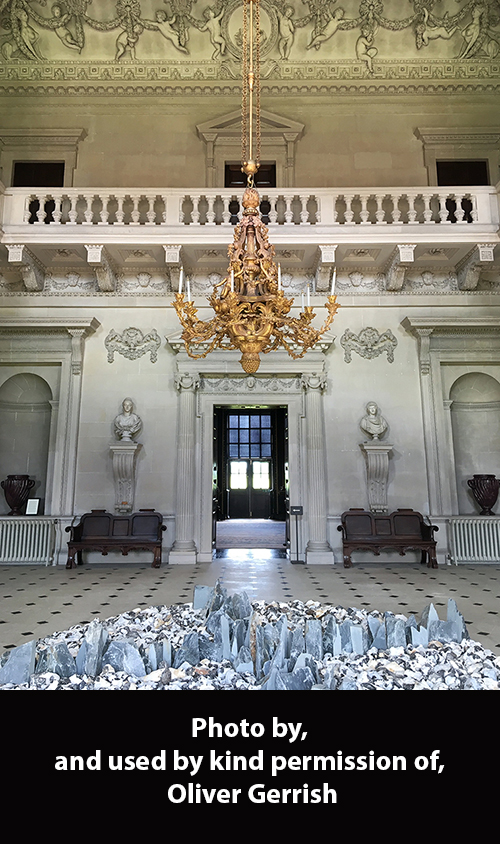
The Stone Hall
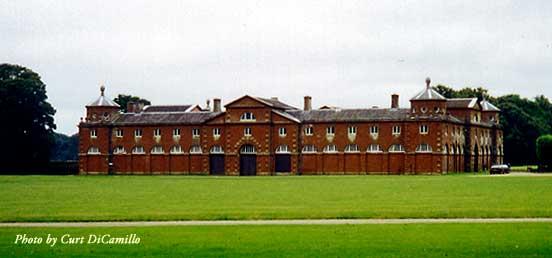
The stableblock
Earlier Houses: Sir Robert Walpole demolished an earlier Charles II house on the site and replaced it with the current house.
Built / Designed For: Sir Robert Walpole
House & Family History: The Saracen's head crest of the Walpole family was supposedly granted in 1191 to a Walpole who fought at the Siege of Acre during the Crusades. The Walpoles had become lords of the manor of Houghton by 1307 and owned the estate until 1797, when the male line died out and it passed to the Cholmondeley family. Sir Robert Walpole, first British prime minister and 1st Earl of Orford, built the current house. Sir Robert inherited his father's Charles II house in 1700, which he later demolished to build his new house (today's Houghton). Sir Robert entered Parliament in 1701, rose rapidly and enjoyed the longest period in power (he was both chancellor of the Exchequer and first lord of the Treasury) in British history, starting in 1721 and running until 1742. In 1726 Sir Robert was the first commoner to be made a knight of the Garter and in 1742 was created 1st Earl of Orford. Richard Wilson and Alan Mackley, writing in "Creating Paradise: The Building of the English Country House, 1660-1880," say that "Sir Robert Walpole, bragging to his neighbor, Lord Leicester, reckoned that Houghton cost him £200,000 (approximately £369 million in 2016 inflation-adjusted values using the labour value commodity index) before he began to burn the bills." During the reign of the 3rd Earl, Sir Robert's grandson, the condition of Houghton deteriorated significantly. The 3rd Earl is remembered primarily for the infamous sale of Sir Robert's unparalleled collection of paintings to Catherine the Great in 1779, and for taking down the steps to the West and East Facades (the steps on the West Facade were restored by Sybil, Lady Cholmondeley, in the 1970s). The 4th Earl was the celebrated wit Horace Walpole; he worked diligently to reduce the debts of the estate and managed to pay off the majority of the mortgages. The 4th Earl's heir was the 4th Earl of Cholmondeley, later 1st Marquess of Cholmondeley (his grandmother was the daughter of Sir Robert). After inheriting the estate in 1797, Lord Cholmondeley paid £10,000 to buy all of Houghton's furniture at the death of the 4th and last Earl of Orford. George, the Prince Regent, was a friend of Lord Cholmondeley and was frequently entertained at Houghton. It's now believed that James Gibbs prepared the first plans for Houghton in 1722 (the famous domes were a design of Gibbs's). About 1723 Colen Campbell replaced Gibbs as architect. Houghton is constructed entirely in Aislaby stone, imported from outside of Norfolk at considerable expense, a feature nearly unique for a Norfolk house. Thomas Ripley revised Campbell's house designs and supervised execution of the house. The pediment of the west façade contains three large sculptures representing Demosthenes, Minerva, and Justice. Grinling Gibbons carved wooden garlands on the Common Parlour chimneypiece. William Kent designed the interiors, including the spectacular Green Velvet Bedchamber, which features the unique circa 1732 green velvet bed designed by Kent with the shell of Venus (today owned by the V&A and on long term loan to Houghton). Mahogany is used in great quantity at Houghton; in no other country house is the exotic wood so freely used. The Tapestry Dressing Room contains two thrones designed in 1847 by A.W.N. Pugin for the House of Lords. These chairs were perquisites of the 5th Marquess when he was lord great chamberlain to Edward VIII. This hereditary office was inherited by the 1st Marquess and is shared with the Heathcote-Drummond-Willoughby family, with the title alternating between each family at every other reign. The thrones are returned to the House of Lords for the state openings of Parliament. The unusual little bed in The cabinet was a gift to Sir Robert by George II and Queen Caroline. The Marble Parlour is one of the earliest rooms in Britain designed expressly as a dining room. It has the unusual feature of access for servants behind its marble chimneypiece. The spectacular Stone Hall was designed by William Kent in collaboration with J.M. Rysbrack, with plasterwork by Giuseppe Artari. The bronze group of the Laocoön is a copy of the classical marble rediscovered in the Vatican in 1506 and was purchased by Sir Robert. The Great Staircase's walls are lined with grisaille canvas paintings by William Kent; the Staircase also contains a bronze copy of the Borghese Gladiator. This immense sculpture sits on an equally large plinth and was a gift to Sir Robert from the 8th Earl of Pembroke. The Cholmondeleys, whose primary seat is Cholmondeley Castle in Cheshire, attempted to sell Houghton a number times over the years. The 1st (Great) Duke of Wellington turned it down as his country seat, as did the future Edward VII, who purchased the neighboring Sandringham instead. The west steps, demolished by the 3rd Earl of Orford due to decay, were rebuilt by Sybil, Lady Cholmondeley, in the 1970s (she sold her Renaissance jewels to pay for the reconstruction). This amazing woman married the 5th Marquess in 1913 and reigned as chatelaine of Houghton for over 70 years. She was responsible for the renaissance of the estate, she and her husband having received Houghton as gift from the 4th Marquess in 1919. In 1984 a 90th birthday party was held at Houghton for Sybil; in attendance were 11 members of the royal family, including the queen.
Collections: William Kent designed the interiors, including the spectacular green velvet bed, which cost the staggering sum of £1,219 in 1732 (approximately £2.2 million in 2016 inflation-adjusted values using the labour value commodity index). The Tapestry Dressing Room contains two thrones designed in 1847 by A.W.N. Pugin for the House of Lords. The bronze group of the Laocoön, purchased by Sir Robert Walpole, is a copy of the classical marble rediscovered in the Vatican in 1506. The staircase contains a bronze copy of the Borghese Gladiator that sits on a large plinth (it was a gift to Sir Robert from the 8th Earl of Pembroke). In 1779 the 3rd Earl of Orford, grandson of Sir Robert Walpole, famously sold Sir Robert's paintings collection, considered one of the greatest in Britain, to Catherine the Great of Russia. The collection of over 80 canvases included works by Rubens, Poussin, and Velazquez, among others. William Kent was commissioned to design custom frames for the paintings so that they complemented the décor of Houghton. In 1975 Sybil, Lady Cholmondeley, purchased Sir Godfrey Kneller's portrait of Joseph Carreras, the only painting sold to Catherine the Great that has returned to Houghton as part of the permanent collection. Between May 17 and September 29, 2013 over 60 canvases from the original collection returned to Houghton from the Hermitage in St. Petersburg and Washington's National Gallery of Art as part of a special exhibition to recreate the original collection as seen in its 18th century setting. Claude's "Landscape with Capricco View of the Arch of Constantine and Flavian Amphitheatre" was sold to Colnaghi Limited of New York at Christie's on December 8, 1989 for £1,325,000. Johann Zoffany's "The Colmore Family" was sold on July 12, 1990 for £2,090,000. Hans Holbein the Younger's "Lady with a Pet Squirrel and Starling," which had been at Cholmondeley Castle since the 18th century (later coming to Houghton), was sold from Houghton to the National Gallery, London, at Christie's in March of 1992 for £10,000,000. A George II walnut library table that once belonged to Sir Robert Walpole at Houghton is now in the Fairhaven Collection at Anglesey Abbey. Philip Stanhope, 4th Earl of Chesterfield, furnished his new London house, Chesterfield House (demolished), with artifacts from an 18th century sale at Houghton, including an 18-candle copper gilt lantern. "The White Duck," painted in 1753 by Jean-Baptiste Oudry, was stolen from Houghton Hall in 1992 and has not been recovered as of May 2013. Houghton contains a collection of 20,000 model soldiers and military memorabilia. In 2014 the Museum of Fine Arts, Houston, mounted an exhibition entitled "Houghton Hall: Portrait of an English Country House" that featured highlights of the collection from Houghton.
Comments: Houghton is considered one of the finest houses in Europe, as well as one of the most spectacular examples of the Palladian style. It is the grandest surviving house of the early Palladian period.
Garden & Outbuildings: Sir Robert Walpole had the Water Tower built between 1731 and 1733 to the designs of Lord Herbert, who later became the 9th Earl ("The Architect Earl") of Pembroke. The current stables were built between 1733 and 1735, the second built by Sir Robert. The first stables, built 1719-21, were the first quadrangle stables built in Britain. Though no records exist as to the present stables' architect, it can be safely attributed to William Kent. Sir Robert had the village swept away in 1729 and replaced by the white cottages that line the approach to the estate today. Charles Bridgeman landscaped grounds in the 18th century. The white gates to Houghton were brought here from Cholmondeley Castle by the 1st Marquess of Cholmondeley and are probably by Robert Bakewell. Today there are over 1,000 head of deer in the park. The walled garden was reborn in the late 20th century and is today devoted to vegetables and fruit, as it would have been in the 18th century.
Chapel & Church: The medieval St. Martin's Church was enlarged by Sir Robert Walpole and has been restored many times over the years. Sir Robert, the 2nd, 3rd, and 4th Earls of Orford are all buried in the Church.
Architect: Thomas Ripley
Date: 1722-35Architect: Colen Campbell
Date: 1722Architect: James Gibbs
Date: 1725-28Architect: William Kent
Date: Circa 1725-35Architect: Thomas Ripley
Date: Circa 1730sArchitect: Henry Herbert (Pembroke and Montgomery)
Date: Circa 1730Vitruvius Britannicus: C. III, pls. 27-34, 1725.
John Bernard (J.B.) Burke, published under the title of A Visitation of the Seats and Arms of the Noblemen and Gentlemen of Great Britain and Ireland, among other titles: 2.S. Vol. II, p. 15, 1855.
John Preston (J.P.) Neale, published under the title of Views of the Seats of Noblemen and Gentlemen in England, Wales, Scotland, and Ireland, among other titles: Vol. III, 1820.
Country Life: xxii, 126, 162; xxxix, 307; xLix, 14, 40, 64, 98, corr. 172; xcvi, 332; cxxvi, 588; cLix, 881; cLxxxi, 18.124, 19.104, corr. 43.129; landscape, cLxxxi, 20.162; cLxxxiii, 9.92; 39/90.108; 17/91.76; 17/91.77; 9/93.50, corr. 15/93.88; 8/94.52; 46/94.50; 50/94.27; 13/96.52; corres 17/96.87; 20/96.112;
Title: Biographical Dictionary of British Architects, 1600-1840, A - SOFTBACK
Author: Colvin, Howard
Year Published: 1995
Reference: pgs. 212, 404, 491, 583, 820
Publisher: New Haven: Yale University Press
ISBN: 0300072074
Book Type: Softback
Title: Sassoon: The Worlds of Philip and Sybil
Author: Stansky, Peter
Year Published: 2003
Reference: pgs. 263-264, 266
Publisher: New Haven: Yale University Press
ISBN: 0300095473
Book Type: Hardback
Title: Anglesey Abbey Guidebook
Author: Fedden, Robin
Year Published: 2002
Reference: pg. 20
Publisher: London: The National Trust
ISBN: NA
Book Type: Light Softback
Title: Creating Paradise: The Building of the English Country House, 1660-1880
Author: Wilson, Richard; Mackley, Alan
Year Published: 2000
Reference: pg. 33
Publisher: London: Hambledon and London
ISBN: 1852852526
Book Type: Hardback
Title: Country Life Cumulative Index: Volumes I to CXCIII to December 1999
Author: NA
Year Published: 2000
Publisher: London: IPC Magazines Limited
ISBN: NA
Book Type: Light Softback
Title: Disintegration of a Heritage: Country Houses and their Collections, 1979-1992, The
Author: Sayer, Michael
Year Published: 1993
Publisher: Norfolk: Michael Russell (Publishing)
ISBN: 0859551970
Book Type: Hardback
Title: Burke's & Savills Guide to Country Houses, Volume III: East Anglia
Author: Kenworthy-Browne, John; Reid, Peter; Sayer, Michael; Watkin, David
Year Published: 1981
Publisher: London: Burke's Peerage
ISBN: 0850110351
Book Type: Hardback
House Listed: Grade I
Park Listed: Grade I
Current Seat / Home of: David George Philip Cholmondeley, 7th Marquess of Cholmondeley; Cholmondeley family here since 1797.
Past Seat / Home of: SEATED AT CURRENT HOUSE: Robert Walpole, 1st Earl of Orford, 1735-45; Robert Walpole, 2nd Earl of Orford, 1745-51; George Walpole, 3rd Earl of Orford, 1751-91; Horatio (Horace) Walpole, 4th Earl of Orford, 1791-97. George James Cholmondeley, 1st Marquess of Cholmondeley and 4th Earl of Cholmondeley, 1797-1827; George Horatio Cholmondeley, 2nd Marquess of Cholmondeley, 1827-70; William Henry Hugh Cholmondeley, 3rd Marquess of Cholmondeley, 1870-84; George Henry Hugh Cholmondeley, 4th Marquess of Cholmondeley, 1884-1923; George Horatio Charles Cholmondeley, 5th Marquess of Cholmondeley, 1923-68; George Hugh Cholmondeley, 6th Marquess of Cholmondeley, 1968-90.
Current Ownership Type: Individual / Family Trust
Primary Current Ownership Use: Private Home
House Open to Public: Yes
Phone: 01485-528-569
Fax: 01485-528-167
Email: [email protected]
Website: https://www.houghtonhall.com
Awards: HHA/Christie's Garden of the Year Award 2007.
Historic Houses Member: Yes